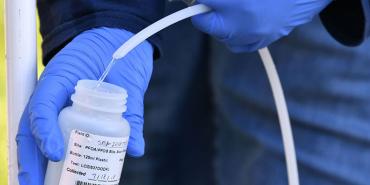
In an ironic twist, in the same city where Gov. Ron DeSantis rolled out his no-holds-barred environmental statement last week, another multimillion-dollar water-contamination crisis has reared its ugly head.
Stuart, Florida's "blue-green algae central," is only just finding out it's knee-deep in more bad.
The same cancer-causing chemicals found in high concentrations underground near Florida State Fire College in Ocala and on military bases around the state, have turned up in lower concentration after testing in three of six separate municipal wells in Stuart, City Manager David Dyess confirmed this week.
Dyess and Stuart commissioners are smart. They've moved quickly, having first taken the contaminated wells offline and installed a specialized filter. Then on Monday Dyess presented the city's plight to the Martin County Legislative Delegation. They aren't waiting until citizens get sick, they're working proactively to find a deep, safe alternative water source. The complete fix is estimated at $16 million. But the first phase is likely to be closer to $2 million, Dyess said.
 At issue is an aqueous film-forming foam, the product firefighters use to train with and to contain fires. The two chemical contaminants in it are called perfluorooctane sulfonate and perfluorooctanoic acid, more commonly known as PFOS and PFOA.
At issue is an aqueous film-forming foam, the product firefighters use to train with and to contain fires. The two chemical contaminants in it are called perfluorooctane sulfonate and perfluorooctanoic acid, more commonly known as PFOS and PFOA.
Studies have shown that perfluorinated chemicals "may be associated with prostate, kidney and testicular cancer, and other health issues," according to the federal Agency for Toxic Substances and Disease Registry.
The Environmental Protection Agency -- after sitting on this health risk for decades -- has yet to set a regulatory limit for the compounds. But in 2016, it published a voluntary health advisory for them, warning that exposure to the chemicals at levels above 70 parts per trillion, total, could be dangerous. Dyess didn't tell me what Stuart's concentrations were specifically in the remaining wells, but he assured me they were not above 70 parts per trillion -- and they are certainly below the levels found last year at the State Fire College.
The Florida Department of Environmental Protection tested wells at the college in August. In two of the three wells, which provide the college’s water supply, officials found levels of the toxic chemicals between 250,000 and 270,000 parts per trillion -- more than 3,000 times higher than the EPA recommended for drinking water.
The city, nevertheless, has filed a lawsuit against 3M and the several companies that manufactured firefighting foam products used in Stuart. Dyess told me he hopes a successful outcome in court will offset the cost of digging three new deep wells.
Stuart contamination was found where firefighters practiced, behind the Stuart Fire Department on East Ocean Boulevard and around the airport -- Witham Field -- where the military drilled for decades, and after them, firefighters from around Martin County.
Freshman state Rep. Toby Overdorf, R-Palm City, though he wasn't assigned to an environmental committee during his first term, also acted quickly. An environmental scientist, Overdorf submitted an appropriations request Thursday for $16 million longterm, but $2 million immediately to engineer, permit and drill the new wells.
"Making sure the citizens of Stuart have safe drinking water has to be our first concern," he said. "These chemicals have proven to migrate through the soil, and without filtration will make it into the shallow aquifer. I am grateful to the city staff for taking such a proactive approach for their citizens. Now my colleagues in the Legislature must do their part for the long-term health and safety of these Floridians."
He also said Stuart's water is below the EPA's PFOS and PFOA contamination level, and that's good. But other studies show the chemicals endanger human health at a far lower level than the EPA has previously called safe. Some states set guidelines for the compounds at lower than the EPA recommendation. Minnesota, for example, set drinking and groundwater levels at 35 parts per trillion for PFOA and 27 parts per trillion for PFOS.
But Overdorf and the Florida Legislature may have a bigger problem with these chemicals in drinking water than just Stuart. The fact is, there are a flock of Stuarts all over this state.
The military is just beginning to check whether chemicals from its firefighting foam might have contaminated groundwater at hundreds of sites nationwide, according to the Defense Department. What they've told us is, California has the most sites with 85, followed by Texas, with 57 and Florida with 38. Thirty-eight -- think about that for a moment. Often, where military firefighters train, local municipalities do, too -- meaning, Uncle Sam will see an escape hatch: The feds aren't likely to accept responsibility for the whole of the tab, let alone fund it.
And the insurance companies? They're stewing over whether they'll see one massive lawsuit combining the hundreds of cases (and growing) involving these cancer-linked firefighting chemicals found in or around a third of Americans’ drinking water -- or will they have to fight each one individually? Whichever it is, I'm betting we're looking at a cattle call of attorneys and settlements in some way future decade.
Although the leaders in Stuart worked quickly to mitigate their problem, the bottom line is this: Florida's water woes, bad as they are already, may be about to intensify immeasurably.
Reach Nancy Smith at nsmith@sunshinestatenews.com or at 228-282-2423. Twitter: @NancyLBSmith


